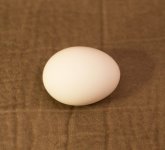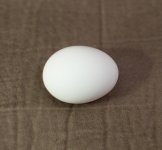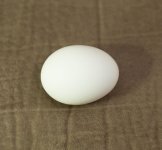Ok, Wayne.
I'm not trying to make you into a convert. I'm just sharing what works for me. I'm pointing out that you're criticizing something you haven't actually tried. I'm addressing the fact you're making several incorrect assumptions. And you are incorrect on several fronts, as I've already noted.
I'v played with the Expodisk version, but it's been a long time, not the 2.0 version. Also with acceptable substitutes, like coffee filters and older Pringles lids. No way I'm going to spend $50 on it now. Reminds me of the $50 Gary Fong flash domes.. people buy them and defend them as the best thing since sex. For $50, it must be something.

But the Expodisk seems too awkward, and I still have to get the image into Adobe raw.
And I have tried the camera Preset method too. I don't fault it at all, if done as Nikon describes it (using neutral cards in the same light), but then I also still have trouble getting it into Abobe raw accurately. Should work better for JPG.
You're incorrect about in-camera WB having no effect on a RAW image, because when you import the image into LR or PS, the WB setting in-camera is your default starting point. I prefer to have that starting point correct or as close to correct as possible before I get started processing the image.
Not incorrect. It is Adobe As Shot that is not correct. Not greatly wrong, just normal WB problems, just not quite an actual match for the camera value. It doesn't take much looking to see that. Except for Preset, it seems pointless even trying to match the camera, the camera didn't know what color the light is.

The point of raw is to set WB after we can see it, and know what we need to do.
You may not be aware, but Nikon does not help Adobe to do that. Nikon really wants to consider the Manufacturers section of the Exif as their proprietary property (they would prefer it not even being the customers property in their images). Back abound 2005, Nikon had a new WB scheme, and they ENCRYPTED it in the D2X and D2HS camera files, for the purpose of keeping third party raw software out of it. There was of course a big customer uproar, and they don't encrypt it now, but they don't help to access it.
Color temperature degrees K is not in the Exif. Cameras don't use degrees K, because 100 degrees difference at 4000K is a greatly larger color change than 100 degrees K at 7000K. They use Mired units, which is 1,000,000 / Temperature, which is more uniform over the range. That's in the camera manual too, menu white balance tweaking is in mired units. But mired is not in the exif either, instead a RGB matrix multiplier. WB is absolutely NOT in the raw file. Some hints are in the Exif, but it has to be interpretted.
You said: "And of course, if you instead aim the Expodisk at the scene, it is falsely affected by colors in the scene, green trees or blue sky, etc. Have you thought that out?"
No, it is not "falsely affected," because all of those colors contribute to the incident light temp in the scene. It is "correctly affected." Sorry.
Come on, really, you're joking, right? The point of the Preset custom setting is to provide it with a neutral area, for Auto WB to then in fact make it be neutral. Any general scene is not neutral. The Expodisk instrutions say to aim it "like an incident light meter".
Have you ever used an incident light meter? We aim them AWAY from the subject, to keep the subject from reporting wrong things. Incident meters are pretty much simply just accurate, reading the light directly, where camera reflected meters aimed at the subject are known to have many problems. It is a Classic problem, which is because the reflectance from the subject colors reflect differently. In the case of WB, it's not about intensity, but about requiring neutral color . If we are going to a neutral WB, we require a neutral area to do it. But intensity is also a factor, dark areas (like 18% gray cards) are really too dark to support much color cast. They do sort of work (altho 18% cards are not spec'd for color neutrality), but WhiBal brand cards made for white balance are a much lighter shade of gray, not far from white.
Auto WB (used in the Preset method) has no knowledge what color the light is, or how the scene ought to look. It's just dumb computer. It can see light blobs, but no clue what is or how it ought to be. Early Auto WB tries (in Photoshop Levels for example) just tried to shift the RGB histogram channels so the bright end points all aligned together. This assumed white there, and called it white balance because equal RGB at the bright end is white. Later better methods in editors now provide the tool to click a KNOWN neutral gray or white area in the picture, and it was made to be neutral, removing the color cast. The cast is NOT recognized, but instead a human operater is saying "this spot should be neutral, so make it be neutral". The computer has no other knowledge of it. It takes our word for what was there, it has no clue about what it is or should be.
Click a green leaf with the WB tool.

It is not allowed to go bizarre, off scale of the histogram, not to all the way to neutral, so it won't look as poor as the plan is poor. But clearly not the right plan.

I shouldn't say green, it is not really worse case. Click red and the image goes green. Click blue and the image goes yellow. Click the orange sunset you mentioned, and it goes deep blue (was that your plan?). Because it tries to neutralize whatever is at that click spot.
You really want to aim Preset WB only at a neutral color. Or the Expodisk at the dominant light source (from the subject). Exactly how all the instructions say to to do it. Except your instructions of course. When we find all about us are wrong, it's a good time to examine our own notions.

So cameras see a lot of green foilage or a lot of blue sky and their goal is to try figure out what color it should really be. But all they know is it is green or blue, etc. Should it be, or not? They all keep their WB algorithms very secret, proprietary, away from competitors, which led to the encryption problem.
You said: "I use a different method. Because the raw WB tool is of course designed for the white card system. So is the camera Preset WB method.
Wrong. The camera preset WB isn't "designed" for anything other than to receive light information from a neutral white/gray colored surface as affected by the environment you're shooting in. The camera doesn't care what source it uses to receive that information.
This is getting too silly to argue with you. Both the current Adobe WB tool and also the Nikon camera Preset tool expect to see a neutral card. The Nikon manual describes very clearly to aim the camera a neutral card in the same light as subject. Expodisk clearly says aim it at the dominant light source.
That way, a human is telling it "this area is neutral, or to be neutral, so make it be neutral". Then the Auto WB does that.
If it was neutral, it ought to work fine.
But if you aim it around at various mixed scenes, there is no rational way you can argue it should work right.
But wait, I thought you just said it wasn't useful to set a custom WB when you're shooting RAW. If you believe that to be the case, why even bother using the white card in any situation?
What I said is this:
Maybe both use the same white card, but for raw, we have to get the custom WB result through the Adobe As Shot mess. WB is not in raw files. JPG ought to get by , but JPG has less range to work with.
Using just the white card, it is already in the picture, already in Adobe , and ready to be clicked. Same white card, but that is a big difference, at least for raw.
And if you do use the white card, then you should know there is no "fiddling with menus" involved. That's the advantage us Nikon shooters have over the Canon shooters, with our handy dandy little "WB" button. Once you're in WB preset mode to begin with, changing to a different WB preset involves a simple press of the white balance and shutter buttons. Hardly daunting.
Changing the WB setting to Custom may be simple, but it only works if after every new scene :
1. you get out the Expodisk.
2. you remove the hood and install the Expodisk.
3. you aim camera at the dominant light from subjects position, and do the thing.
4. you remove Expodisk and reinstall lens hood.
Then OK, you're ready to go with the Preset menu, until your scene or lighting changes again... which I call serious fiddling.
Using the white card, you just place it in the scene, one way or another. In sunlight, you can just hold it arms length in front of the camera (focus is not necessary), but otherwise, it does need to be at the subject, in the same light.
Or as I mentioned, many casual scenes already have something white enough which often can work. Not precise, but often adequate, better than no try at all.
You can point it in any direction you wish, and as long as you are aiming it somewhere in the environment you're shooting and not into the shadows, you'll get a good result.
Just be sure to aim it to fill the frame with something neutral gray or white. ROFL.
Even if you didn't, so what? It's not as if you can't adjust in post.
So what was the point of doing it wrong?
I also said it isn't required or even desirable for all situations and plainly explained its limitations. It's a useful tool to have, and I believe it's the best tool to use for in-camera WB for interior shots and portraits. Even if I used it in only for portraits, in controlled interior lighting exclusively, it's still worth the $50 I spent on it TO ME, as skin tones have always been the most difficult thing for me to get adjusted correctly in all situations.
Go for it then, but it is not for me. Not sure I would be interested even without the Adobe As Shot issue.
It seems neither one of us is listening to or understanding what the other is saying, so I think we're done here.




